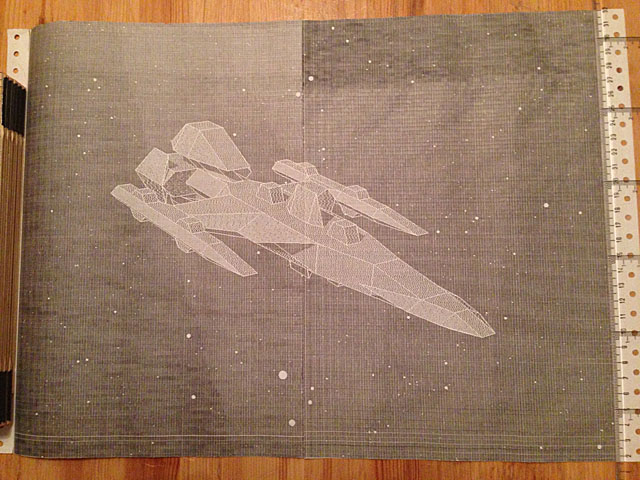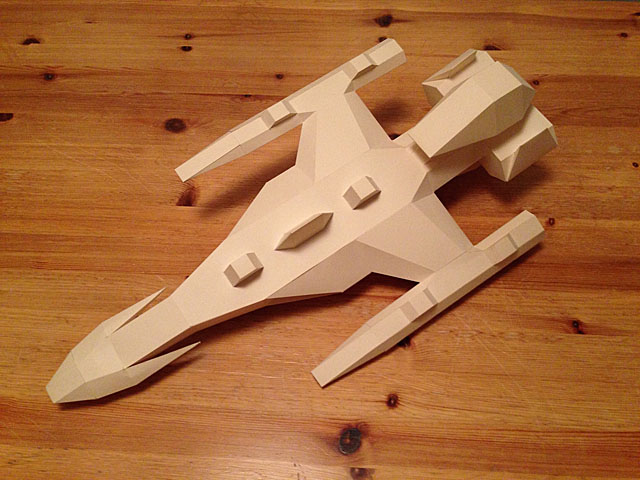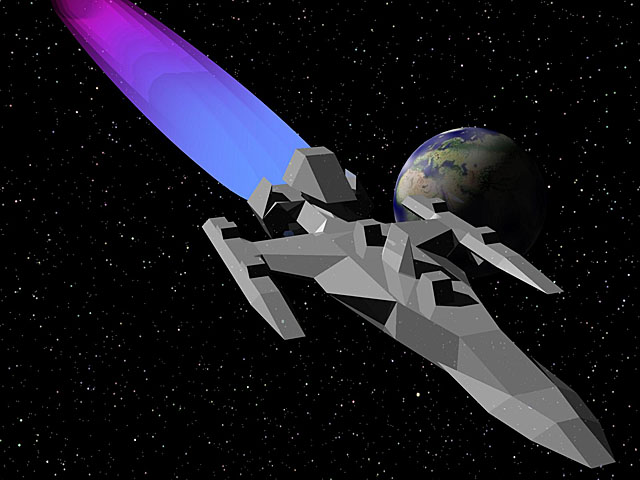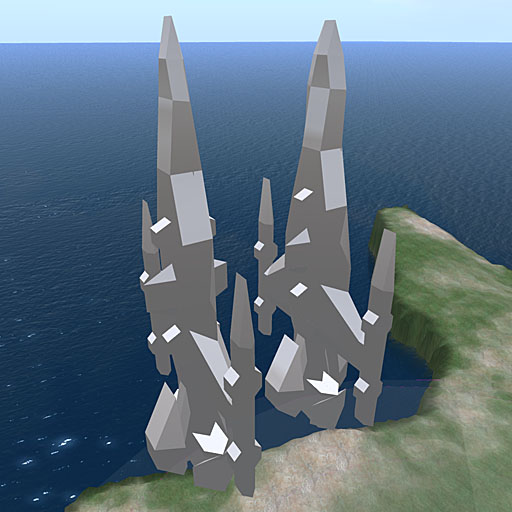
Spaceship Salamander 3B, ABC800 rendering (1981, photographed 2017-02-26)
This tale was inspired by the fact that I finally learned a way to create mesh for OpenSimulator, without going through the hassle of learning the 3D program Blender. Instead I can fall back on some 10 years of experience in creating mesh models in the 3D program Carrara.
In 1977, my father got a computer with the intention of letting it handle the administration of his small company. He never managed to learn it enough to use it for that purpose, so it ended up becoming my toy. It was called ABC80, (Swedish Advanced Basic Computer for the 80's, introduced 1978, but my father got one of an early 40 unit test series), and was at the time state of the art of then so-called micro-computers, with its 2.2 MHz 8 bit Z80 processor, 16 KB RAM, a black-and-white screen with 24x40 text or 78x72 resolution graphics, semi-compiling BASIC interpreter, and a radio casette recorder used as its mass memory, able to store 300 KB of data on a 2x30 minute casette tape. In 1978, I had written programs to render my first 3D scenes with the edges of a few simple mesh bodies on the screen. Remember, this was still a few years before the Atari 400/800 (late 1979) and Amiga 1000 (mid 1985), but contemporary with Commodore PET, Apple II and TRS-80 (all 1977).
In 1981, I had outgrown the ABC80 and nagged my father into getting its descendant, the ABC800, with the same processor and similar mass storage, but with an astounding 32 KB RAM and with 4-color 240x240 resolution graphics. When I also got a 2x640 KB 5 1/4 inch floppy disk station as mass storage, only the sky was the limit. Within months, I managed to write a two-pass (light and shadows) rendering program, to draw a 332 face mesh model of a space ship I had created for a science fiction story I was writing at the time. It took 2 weeks to render it against a starry background and print it diffusion dithered in high resolution (2304x1152 pixels) on two 8x12 inch paper sheets using a black-and-white matrix printer. On a side note, it was the same knowledge about 3D calculations and programming used for this purpose that enabled me to submit the llCastRay v3 implementation to OpenSimulator core in 2015.

Spaceship Salamander 3B, ABC800 rendering (1981, photographed 2017-02-26)
What I didn't know at the time, and didn't find out until much later, was that what I had accomplished was considered impossible, at least with a simple USD 3,000 micro-computer, but should require a USD 100,000-200,000 Silicon Graphics work station, or similar, with custom written programs costing about as much. Had I known, and realized the commercial potential of my feat, my life probably would have looked quite a bit different. But at the time, to me it was just a fun challenge, to see if I could accomplish it.
Soon after I had printed the first full rendering of the space ship, I also built a paper model of it, 512x256x128 mm (20x10x5 inches), all 332 faces, with glue tabs and of course projected to 2D drawings from the same mesh model and by the same computer I had used to render it. Both the initial rendering and that paper model are still intact in my possession after all these years and a number of moves, and it's possible even the programs to render and make drawings from it are saved somewhere in a thick pile of printouts I have kept, while I doubt the floppy disks I saved them on are readable after 35 years.

Spaceship Salamander 3B, paper model (1981, photographed 2017-02-26)
In 1982, I went to university, and my focus needed to shift from playing with computers to studying, and later working, but I still kept playing around some with computers and 3D. In 1994, I got hooked on the then emerging WWW, and in 1995 I created my first 3D scenes for the web using VRML, later X3D. In 1999, I started to work with commercial 3D programs, like RayDream Studio, and in 2001, my then 20 years old spaceship was revived as a mesh model created in RayDream Studio's descendant Carrara.

Spaceship Salamander 3B, Carrara rendering (2001)
In 2007, I entered Second Life, and in 2008, I started testing OpenSimulator, but it wasn't until 2016-07-02 that my old spaceship was re-created as an 85-prim (all procedural and many heavily tortured) model in OpenSimulator. Finally, 2017-02-25, I managed to also import it as a 1070 vertices / 588 triangles mesh model, my first own real mesh import ever, save for a few tests with simple cubes and cylinders before. On the image, the old prim model is to the right, while the new mesh model is to the left. No visible difference really, which was just what I hoped for.

Spaceship Salamander 3B, OpenSimulator mesh (2017) and prim (2016)
The way I finally got the mesh model uploaded was by exporting it as generic (not DAZ) Collada from DAZ Carrara 8.5, without transforms and morphs, with texture maps and full path file names, then importing them into Blender 2.74, selecting just the mesh, and re-exporting selection only as Collada, before uploading the re-exported file into OpenSimulator. The re-export is needed since there is something about the Carrara Collada format that OpenSimulator doesn't like, but which is fixed by just importing and re-exporting in Blender. This approach also handles UV coordinates, multiple-textured meshes and creased/uncreased edges from Carrara without problems, but does not translate Carrara's advanced reflection model into the simple shininess of OpenSimulator / Second Life. This was tested using a few simple test models.
http://binders.world/mesh/tale.html © 2017 Binders World
Created 2017-02-26 and updated 2017-03-02 by magnuz.binder@gmail.com